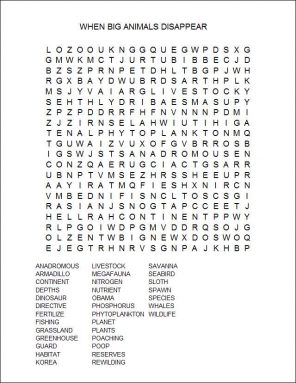As big animals poop out
Extinction of Earth’s biggest creatures has shrunk the cycle that fertilizes continents
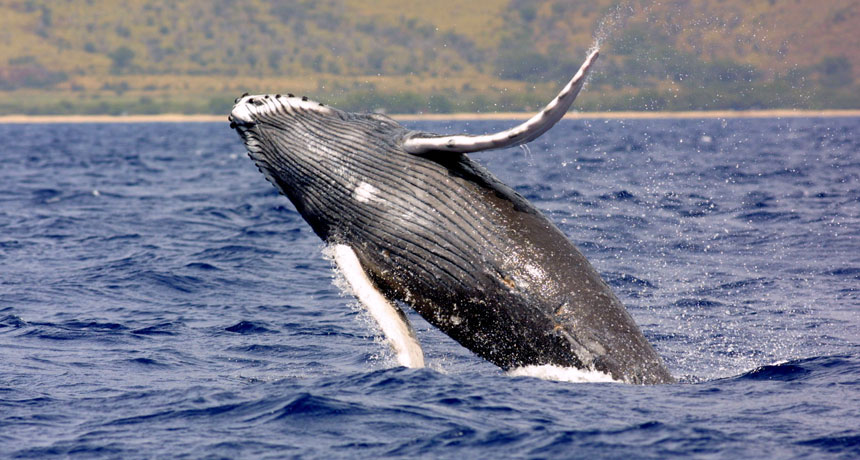
Whales help move nutrients out of the ocean depths, starting a global cycle. But as whales have decreased in numbers, that cycle has slowed.
NOAA
Long after the dinosaurs died out some 65 million years ago, many giants continued to roam the Earth. Some mammals were big as backhoes! Mammoths grazed on grasslands, and elephant-sized ground sloths tore apart tree branches with sharp claws. Millions of whales cruised the oceans.
Collectively, these megafauna — the scientific term for very large animals — ate mega-size meals. Then they went on to shed mega-quantities of poop.
And that was a good thing.
The huge quantities of feces shed by the big animals contained leftover nutrients from the food on which they had dined. That poop fed a global cycle that moved nutrients like phosphorus and iron from the ocean to the land. These nutrients fed plants, animals and other organisms around the world.
But this cycle has shrunk dramatically, a new study finds.
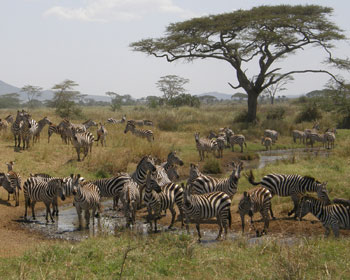
By virtue of their size, big animals can quickly move lots of nutrients across large distances. Most of the world’s giant mammals, though, are now extinct. There are a few left, like rhinos, elephants and whales. But there were far more in the past. Around 12,000 years ago, “almost everywhere looked like an African savanna,” notes Christopher Doughty. An ecologist, he works at the University of Oxford in England.
Since then, however, humans have killed off many of the big animals, mostly for food. Large animal species that still exist are far fewer in number than they once were. Plus, people have been altering ecosystems in ways that can make it harder for important players in the nutrient cycle to survive.
As the numbers of whales and fish have been falling, fewer ocean nutrients have been reaching the land. Of nutrients that do, fewer are traveling inland as fast as they once did.
Without those nutrients, plants won’t be able to grow as well. As a result, the total weight of all the Earth’s vegetation will decline, observes Joe Roman. A coauthor of the new study, Roman is a biologist at the University of Vermont in Burlington.
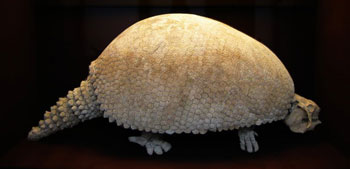
The decline in vegetation will have a cascade of effects. Animals will have less to eat. That will lead to fewer animals, and a further drop in the spread of nutrients. That’s the conclusion Doughty, Roman and their colleagues reported October 26 in the Proceedings of the National Academy of Sciences.
Less plant growth means less carbon dioxide will be removed from the air. Carbon dioxide is a greenhouse gas and a major cause of global warming.
“We need to keep as many animals on the planet as possible,” says Roman. And livestock, such as cows and sheep, won’t work. Most of those animals are kept fenced in, so that they cannot participate in the long-range recycling and dispersal of nutrients. What the planet needs, he argues, is wild, free-roaming, big animals.
How animals spread the wealth
Nutrient recycling begins at sea, with whales. Many whales feed deep in the ocean. Because they breathe air, they spend much of their time at or near the surface. They also poop there. That releases the nutrients that the whales had gathered far below through feeding. Had whales not eaten them, these nutrients “might otherwise have been locked up in the depths for thousands of years,” notes Roman.
Among the sea life that benefit from the whale wastes are plankton. Most of these tiny organisms range from the microscopic to biggies the size of fleas. But what they lack in size they make up for in quantity. Plankton can form massive colonies — ones big enough to be seen from space. More importantly, they are a major source of food in the seas.
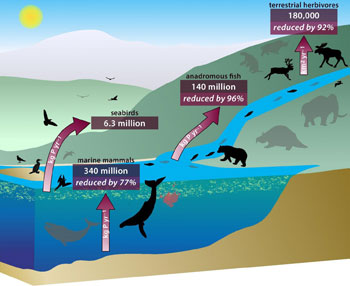
The nutrients that whales poop out, like phosphorous and nitrogen, fuel the growth of phytoplankton, Roman notes. Zooplankton eat phytoplankton, and fish eat zooplankton.
But the nutrients that start in plankton don’t remain in the sea. Some of the fish that consume them transport them to land. How? Some fish, such as salmon, don’t live their entire lives in the ocean. They are called anadromous (Ah-NAD-druh-mus) species. Born in freshwater, they swim to the ocean where they spend the bulk of their lives. But when they are ready to reproduce, they swim back into the rivers of their birth. There they spawn — and often die.
In that trek up rivers to reproduce, the fish shed nutrient-rich wastes into the fresh water. The bodies of the fish that die after spawning will rot. This will release the nutrients in their bodies.
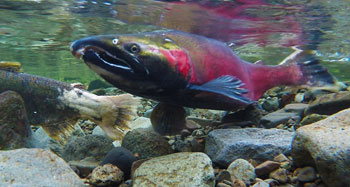
It is here that big animals are particularly important. Nutrients deposited too close to a river, or in a floodplain, may wash back into the river and eventually into the ocean. Big animals travel farther than small ones between a meal and a pit stop. Thus, nutrients from the fish they eat are more likely to be shed far enough away to avoid washing back to sea.
These nutrients now fertilize plants farther away. They, in turn, will be eaten — and then pooped, to fertilize anew. And between eating and pooping, animals both large and small transport the nutrients in all directions. Over thousands of years, the nutrients eventually spread across entire continents.
Or that’s how it used to be.
Loss of big animals has huge impact
At the end of the most recent ice age, about 12,000 years ago, there were at least 48 types of very large, plant-eating animals, says Doughty. Of those 48, just nine remain. None of them live in North or South America.
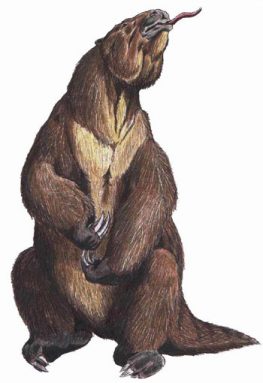
Almost no whale species have gone extinct since 1700. Still, there has been a dramatic drop in the number of whales since then, due to hunting (called whaling). Whalers harvested so many animals that the total weight of all current marine mammals (which also include seals, walruses and otters) is now between one-third and one-tenth of what existed some 300 years ago.
Whaling nearly took out the blue whale, the largest species that has ever lived. Each weighs an average of 91 to 136 metric tons (100 to 150 U.S. short tons). That’s about the weight of between 62 and 92 full-sized Honda sedans. Back around 1700, some 350,000 blue whales cruised the oceans. Today, there may be no more than 5,000 to 25,000 left.
Doughty’s team calculates that before whaling, marine mammals moved roughly 340,000 metric tons of phosphorus from the ocean’s depths to its surface each year. Today, they move only about one-fifth as much.
A WHALE OF A… Whales tend to mine nutrients at depth, then release them as feces at or near the surface. In this case, a diver just happened to get caught up in a whale’s massive, minutes-long evacuation of its bowels. And yes, he notes, it smelled rather rank. bbc.co.uk/5live |
Birds and fish once moved another 136,000 metric tons of phosphorus from the sea to the land. Following centuries of intense fishing, Doughty’s team finds, only one anadromous fish remains for every 20 that existed 300 years ago. That sharp decline largely explains the big drop in the amount of phosphorus from the sea that makes it to land. Moreover, river dams now keep many anadromous fish from swimming upriver. This has prevented even more phosphorus from reaching land.
In fact, researchers estimate that less than 4 percent as much phosphorus reaches land as what had been typical before commercial deep-sea fishing and whaling began. Overall, Earth’s nutrient cycles now move only about 5 percent as many nutrients across long distances as they did 12,000 years ago.
“The huge reduction in movement of nutrients is alarming,” says Richard Ostfeld. He’s an ecologist at the Cary Institute of Ecosystem Studies in Millbrook, N.Y., and was not involved in the research. “These nutrients are needed to maintain natural ecosystems and agriculture.”
Is there hope?
The situation is dire, says Roman. One measure that shows just how bad it has become is the Living Planet Index. This report is issued by WWF (formerly known as the World Wildlife Fund). Since 1970, this index has been tracking the population size of more than 3,000 wild species of vertebrates — animals with backbones. These animals include mammals, birds, fish, reptiles and amphibians. In 2014, the index reported that these populations had dropped, on average, to less than half of what they had been just 44 years earlier.
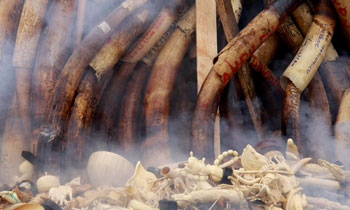
Wildlife reserves are places where animals and plants are protected. The report also found that populations of big land animals within such reserves have dropped by only 18 percent since 1970. That’s far less than the overall 39 percent average drop in such land-based populations across the globe. Those data show that establishing wildlife reserves can help protect species. Still, the report warns, some poor nations lack the money needed to pay for guarding wildlife populations in their reserves.
Another important move has been a United Nations resolution against wildlife crime, says a WWF spokesperson. This measure commits member nations to combat activities such as poaching and the sale of endangered animals (and their parts, such as shark fins and rhino horns). Poaching is one of the biggest threats to African wildlife, including elephants, rhinos and gorillas.
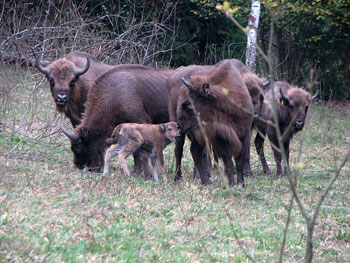
Wolves, bears and lynx have also been returning to sites in Europe, notes Doughty. Most important to that growth has been a program in the European Union, or EU, known as its “habitats directive.” The EU told its 28 member countries to take actions to preserve and revive rare species. The directive also will protect different types of ecosystems important to animals. These include special types of forest, meadows and wetlands.
The decline in whales was halted by a ban on whaling that began in the 1980s. Iceland, Norway and Japan continue to kill small numbers of whales. Still, “whale populations are beginning to grow again,” Roman points out.
The whaling ban offers hope that populations of these huge mammals may substantially recover. And if they do, perhaps the quantities of nutrients they bring from the oceans’ depths to the water’s surface will grow once again. And if the decline of big land animals is slowed, or even reversed, poop-borne nutrients may once again fertilize continents.
Power Words
(for more about Power Words, click here)
agriculture The growth of plants, animals or fungi for human needs, including food, fuel, chemicals and medicine.
amphibians A group of animals that includes frogs, salamanders and caecilians. Amphibians have backbones and can breathe through their skin. Unlike reptiles, birds and mammals, unborn or unhatched amphibians do not develop in a special protective sac called an amniotic sac.
anadromous Adjective refers to fish that live in the ocean but that lay their eggs far up rivers. (not in glossary)
biology The study of living things. The scientists who study them are known as biologists.
carbon dioxide A colorless, odorless gas produced by all animals when the oxygen they inhale reacts with the carbon-rich foods that they’ve eaten. Carbon dioxide also is released when organic matter (including fossil fuels like oil or gas) is burned. Carbon dioxide acts as a greenhouse gas, trapping heat in Earth’s atmosphere. Plants convert carbon dioxide into oxygen during photosynthesis, the process they use to make their own food. The abbreviation for carbon dioxide is CO2.
carnivore An animal that either exclusively or primarily eats other animals.
commercial (in research and economics) An adjective for something that is ready for sale or already being sold. Commercial goods are those caught or produced for others, and not solely for personal consumption.
continent (in geology) The huge land masses that sit upon tectonic plates. In modern times, there are six geologic continents: North America, South America, Eurasia, Africa, Australia and Antarctica.
crustaceans Hard-shelled water-dwelling animals including lobsters, crabs and shrimp.
dinosaur A term that means terrible lizard. These ancient reptiles lived from about 250 million years ago to roughly 65 million years ago. All descended from egg-laying reptiles known as archosaurs. Their descendants eventually split into two lines. They are distinguished by their hips. The lizard-hipped line became saurichians, such as two-footed theropods like T. rex and the lumbering four-footed Apatosaurus. A second line of so-called bird-hipped, or ornithischian dinosaurs, led to a widely differing group of animals that included the stegosaurs and duckbilled dinosaurs.
directive An instruction or declaration of required action that is issued by some official, nation or authoritative organization (such as the United Nations or North Atlantic Treaty Organization).
disperse To spread, often widely. Plants, for example, disperse their seeds to far off sites by allowing them to ride the winds or survive being eaten by animals that travel great distances.
ecology A branch of biology that deals with the relations of organisms to one another and to their physical surroundings. A scientist who works in this field is called an ecologist.
ecosystem A group of interacting living organisms — including microorganisms, plants and animals — and their physical environment within a particular climate. Examples include tropical reefs, rainforests, alpine meadows and polar tundra.
European Union The confederation of 28 European countries that have agreed to work peacefully together. Residents of EU can move freely between its member countries and sell goods to them. Most members have also adopted the same currency, known as the Euro.
extinction The permanent loss of a species, family or larger group of organisms.
fauna The animal species that live in a particular region or at a particular period of time.
feces A body’s solid waste, made up of undigested food, bacteria and water. The feces of larger animals are sometimes also called dung.
fertilize (in agriculture and horticulture) To provide basic chemical nutrients for growth.
floodplain The nearly flat land that runs along the side of a river, for some distance out from the water. When the river floods, it spills over into this plain, which is built up, over time, with the silt left as the waters recede. That silt tends to be soil that eroded off of the upstream lands during rains.
food web (also known as a food chain) The network of relationships among organisms sharing anecosystem. Member organisms depend on others within this network as a source of food.
global warming The gradual increase in the overall temperature of Earth’s atmosphere due to the greenhouse effect. This effect is caused by increased levels of carbon dioxide, chlorofluorocarbons and other gases in the air, many of them released by human activity.
glyptodont Large, heavily armored animals that are relatives of armadillos and now extinct.
greenhouse gas A gas that contributes to the greenhouse effect by absorbing heat. Carbon dioxide is one example of a greenhouse gas.
habitat The area or natural environment in which an animal or plant normally lives, such as a desert, coral reef or freshwater lake. A habitat can be home to thousands of different species.
livestock Animals raised for meat or dairy products, including cattle, sheep, goats, pigs, chickens and geese.
mammal A warm-blooded animal distinguished by the possession of hair or fur, the secretion of milk by females for feeding the young, and (typically) the bearing of live young.
marine Having to do with the ocean world or environment.
mega A prefix for units of measurement meaning million in the international metric system.
megafauna Large or giant animals.
nitrogen A colorless, odorless and nonreactive gaseous element that forms about 78 percent of Earth’s atmosphere. Its scientific symbol is N. Both animals and plants need it for growth and to form their cells. (in environmental science) Nitrogen is released in the form of nitrogen oxides as fossil fuels burn.
nutrient A vitamin, mineral, fat, carbohydrate or protein needed by organisms to live, and which is extracted through the diet.
organism Any living thing, from elephants and plants to bacteria and other types of single-celled life.
phosphorus A highly reactive, nonmetallic element occurring naturally in phosphates. Its scientific symbol is P.
phytoplankton Sometimes referred to as microalgae, these are microscopic plants and plant-like organisms that live in the ocean. Most float and reside in regions where sunlight filters down. Much like land-based plants, these organisms contain chlorophyll. They also require sunlight to live and grow. Phytoplankton serve as a base of the oceanic food web.
plankton A small organism that drifts or floats in the sea. Depending on the species, plankton range from microscopic sizes to organisms about the size of a flea. Some are tiny animals. Others are plantlike organisms. Although individual plankton are very small, they form massive colonies, numbering in the billions. The largest animal in the world, the blue whale, lives on plankton.
poach (in ecology) To illegally hunt and take a wild animal or plant. People who do this are referred to as poachers.
population (in biology) A group of individuals from the same species that lives in the same area.
predator A creature that preys on other animals for most or all of its food.
rainforest Dense forest rich in biodiversity found in tropical areas with consistent heavy rainfall.
random Something that occurs haphazardly or without reason, based on no intention or purpose.
recycle To find new uses for something — or parts of something — that might otherwise be discarded, or treated as waste.
reptile Cold-blooded vertebrate animals, whose skin is covered with scales or horny plates. Snakes, turtles, lizards and alligators are all reptiles.
rewild A relatively new term for the return of ecosystems filled with wild species in places where at some earlier period they had been driven out or fenced out.
savanna A grassland sometimes also populated with trees. Most are fairly dry for part or much of the year.
sloth A slow moving, plant-eating mammal that lives in tropical rainforests in the Western Hemisphere. Most of these tree dwellers sleep all but four to nine hours a day.
spawn To release or fertilize eggs in an aquatic environment.
species A group of similar organisms capable of producing offspring that can survive and reproduce.
terrestrial Having to do with planet Earth, especially its land. Terra is Latin for Earth.
tropics The region near Earth’s equator. Temperatures here are generally warm to hot, year-round.
vegetation Leafy, green plants. The term refers to the collective community of plants in some area. Typically these do not include tall trees, but instead plants that are shrub height or shorter.
vertebrate The group of animals with a brain, two eyes, and a stiff nerve cord or backbone running down the back. This group includes amphibians, reptiles, birds, mammals and most fish.
wetland As the name implies, this is a low-lying area of land either soaked or covered with water much of the year. It hosts plants and animals adapted to live in, on or near water.
whale A common, but fairly imprecise, term for a class of large mammals that lives in the ocean. This group includes dolphins.
whaling The business of hunting whales. The practice reached its peak in the early 20th century and nearly drove many species extinct.
woolly mammoth A type of extinct mammal that resembled a hairy elephant.
zooplankton Small organisms that drift in the sea. Zooplankton are tiny animals that eat other plankton. They also serve as an important food source for other marine creatures.
Word Find (click here to enlarge for printing)
